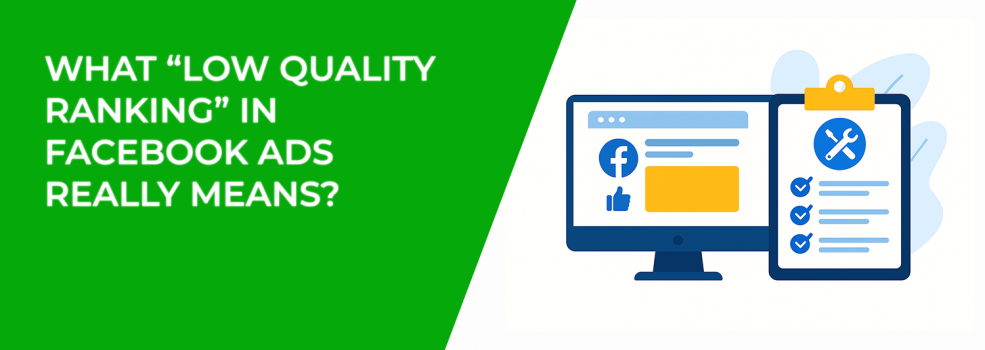Ever opened Ads Manager and seen the words “Low Quality Ranking”? Ouch. It feels like Facebook is giving your ad a big thumbs down. But what does that label actually mean? And how do you fix it without wasting more budget?
Let’s break it down in a way that actually makes sense.
What Ad Quality Really Is
Facebook doesn’t just want ads that make money. It wants ads people like seeing. That means your bid isn’t the only thing that matters — quality counts, too.
Here’s what Facebook looks at when it decides if your ad is high or low quality:
-
How people react (do they hide your ad or report it?).
-
Signals that suggest spammy or misleading tactics.
-
Engagement that shows if people care about your ad or scroll right past.
The higher the quality, the better your ad performs in the auction. The lower the quality, the harder and more expensive it becomes to reach people.
If you want to dig deeper into how Facebook’s ad system works behind the scenes, check out this guide on Meta Ad Campaign Objectives. Choosing the right campaign setup can make or break how much “quality” Facebook expects from your ads.
Why Low Quality Ranking Is a Problem
A bad ranking isn’t just an annoying label. It directly affects how your ads run. When quality drops, here’s what usually happens:
-
Your costs go up – More money for fewer clicks or conversions.
-
Your reach shrinks – Facebook gives your ad less space in the feed.
-
Your account can take a hit – If you keep running weak ads, Facebook might start treating your whole Page or domain as low quality.
That’s why ignoring the ranking is risky. Even new campaigns can get dragged down if your account builds a “low quality” history. If you’re seeing symptoms like poor delivery, you’ll also want to understand issues such as why ad sets may get zero reach.
How to Check Your Ad Quality
Want to know where you stand? Head to Meta Business Support Home. It’s like a dashboard for your ad health. In there, you can:
-
Compare your ad’s quality score against others targeting the same audience.
-
Spot issues with your Page, account, or ads that break policies.
-
Ask for a review if you think an ad was flagged unfairly.
Even more useful are the ad relevance diagnostics. These show you not just quality, but also engagement and conversion rankings. Look at all three together, and you’ll see exactly where things are falling apart.
For example, if you see “Below Average (bottom 20%)”, it means your ad was rated lower than 80% of other ads shown to the same people. Tough, but fixable.
What Causes Low Quality Ranking?
Facebook’s system flags ads when they feel spammy, misleading, or just plain annoying. The most common triggers are:
-
Engagement bait (“Tag your friends!” or “Share if you agree”).
-
Clickbait or hidden info (“You won’t believe what happens next…”).
-
Sensational language that sounds too pushy.
-
Landing pages that don’t match the ad promise.
-
The same stale ad running again and again.
Think about it: if you were scrolling, would you click on your ad? If the answer is no, your audience probably feels the same. If that sounds familiar, you may also be dealing with Facebook ads not converting, which often overlaps with low quality issues.
How to Improve Your Facebook Ad Quality
Here’s the good news: you can recover. A low score isn’t permanent. Try these steps to raise your quality ranking:
-
Match your ad and landing page
Keep the message consistent. If your ad offers “free shipping,” make sure that’s front and center on the landing page. -
Show real value
Use clear benefits, real photos, and honest testimonials. No tricks needed. -
Keep things fresh
Rotate creative often. New images, videos, and headlines stop people from tuning out. -
Drop the gimmicks
Skip clickbait, hype, and engagement bait. They might spike attention short-term, but Facebook’s system will punish them fast. -
Use diagnostics
Don’t just look at the label “Low Quality Ranking.” Compare engagement and conversion scores too. Together, they tell the real story.
Need help refining your audience so quality improves faster? Check out this practical guide on defining your target audience step by step.
Why Quality Matters More Now
Since mid-2024, Facebook has tightened the rules on dynamic creative. That means you can’t just rely on the system to shuffle headlines and images for you when running certain campaign types.
In other words, the responsibility for creating high-quality ads is now all on you. Low-quality ads fade away. High-quality ads win cheaper results and better visibility. Simple as that.
If you’re already fighting ad fatigue, don’t miss this guide on spotting and fixing ad fatigue fast. It’s often the hidden reason behind low quality scores.
Final Thoughts
“Low Quality Ranking” in Facebook Ads isn’t a random label — it’s Facebook’s way of saying your ad doesn’t measure up to others in the same auction. That hurts your reach, your costs, and potentially your whole account.
But you’re not stuck. By making ads relevant, skipping spammy tactics, and paying attention to diagnostics, you can flip the script. Better quality means more people see your ads, your costs go down, and your campaigns actually work.
So, the next time that low ranking shows up, don’t ignore it. Use it as a wake-up call to improve your creative. Your audience — and your budget — will thank you.

